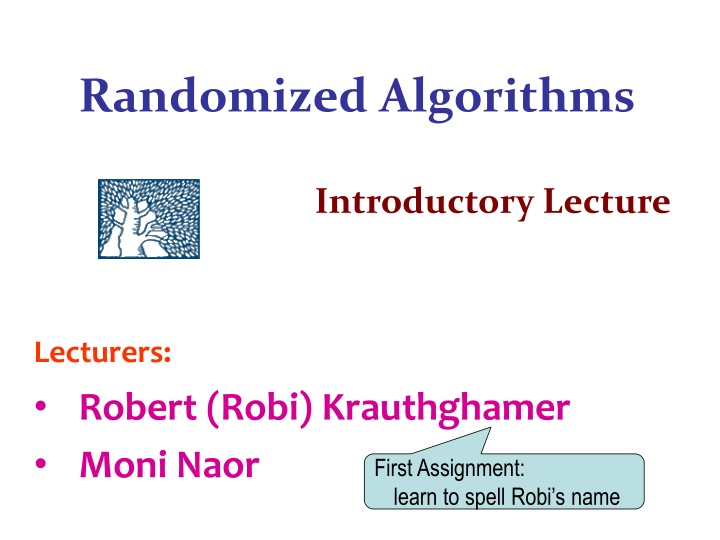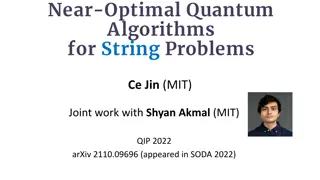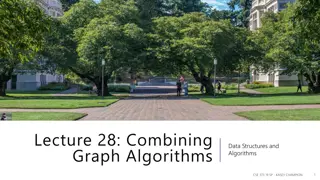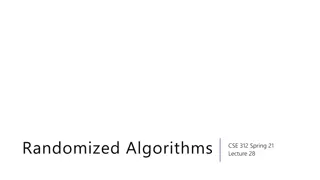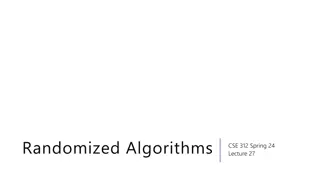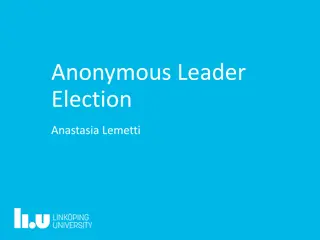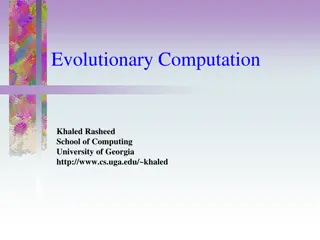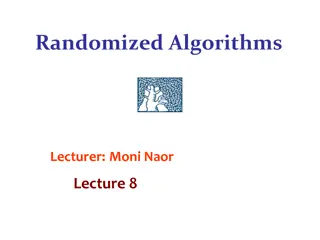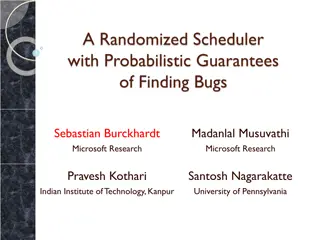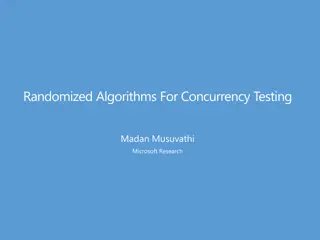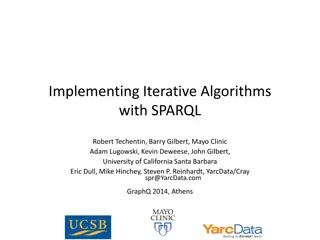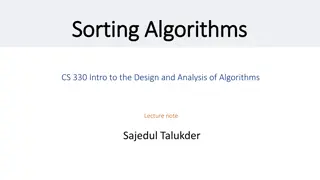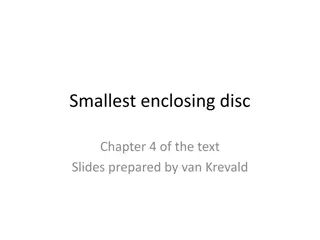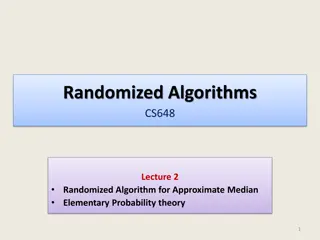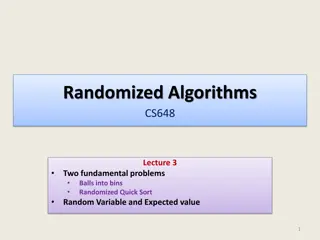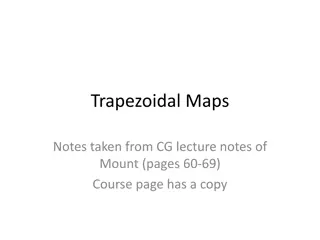Randomized Algorithms
Randomized algorithms provide efficient solutions to complex problems by leveraging randomness. From finding global minimum cuts to exploring distributed algorithms, this lecture series delves into the realm of randomized complexity classes. Through examples and discussions on differential privacy and PCP Theorem, students are introduced to the power and versatility of randomized algorithms. The course covers key topics such as sublinear time complexity, cryptography, and constructing objects beyond worst-case scenarios. Lectures emphasize worst-case analysis while considering distributions on input, showcasing the simplicity and effectiveness of randomized algorithms.
Download Presentation

Please find below an Image/Link to download the presentation.
The content on the website is provided AS IS for your information and personal use only. It may not be sold, licensed, or shared on other websites without obtaining consent from the author.If you encounter any issues during the download, it is possible that the publisher has removed the file from their server.
You are allowed to download the files provided on this website for personal or commercial use, subject to the condition that they are used lawfully. All files are the property of their respective owners.
The content on the website is provided AS IS for your information and personal use only. It may not be sold, licensed, or shared on other websites without obtaining consent from the author.
E N D
Presentation Transcript
Randomized Algorithms Introductory Lecture Lecturers: Robert (Robi) Krauthghamer Moni Naor First Assignment: learn to spell Robi s name
Administrivia Meetings: Mondays 14:15-17:00 It is expected that all students attend all lectures and actively participate in classes Read material before class Present in class hw solutions etc. Interact during lectures Test Lectures are recorded (please remind the speaker to start)
Course: Sources: Mitzenmacher and Upfal Probability and Computing Motwani and Raghavan Randomized Algorithms A few lectures from Ryan O'Donnell's course ``A Theorist's Toolkit"
Today Why? Min Cut 2-SAT Randomized Complexity Classes Next time
Why Randomized Algorithms? May solve problems faster than deterministic ones May be essential in some settings: Sublinear time complexity realm Distributed algorithms, e.g. for breaking symmetry Cryptography and privacy Yield construction of desirable objects that we do not know how to build explicitly. Beyond worst case analysis: analyze algorithms when assuming some distribution on the input, or some mixture of worst case and then a perturbation of the input (smoothed analysis). Example: PCP Theorem Example: Differential Privacy
Why Randomized Algorithms? Prob is over its choice Our emphasis would be worst case We assume the algorithm or computing device receives in addition to the input also a random `tape like the other tapes of the Turing Machine, but this one with truly random symbols. Or other models Decision tree Communication complexity Random tape A nice feature that some randomized algorithms have is that they are simple. Will demonstrate this in two algorithms.
Global Minimum Cut? Find a partition (A, B) of V s. t. the number of edges crossing from A to B is of minimum cardinality. G = (V, E) d A B b f Size of mincut is 3 Several such cuts a h g c
Global Minimum Cut Global min cut: Given a connected, undirected graph G = (V, E) find a cut (A, B) of minimum cardinality. Applications: Partition items in a database, cluster documents, network reliability, network design, TSP solvers. Network flow approach: run (n-1) s-t min cut (flow) Which is harder: Global min-cut or min s-t cut?
Basic operation: edge contraction Contract an edge e = (u, v). replace u and v by single new super-node w preserve edges, update endpoints of u and v to w keep parallel edges, but delete self-loops e =(b,c) d Mincut does not decrease as a result of contraction Might increase if you hit the mincut b f a h g c
Contraction algorithm [Karger 1995] Pick an edge e = (u, v) uniformly at random. Contract the edge e. replace u and v by single new super-node w preserve edges, update endpoints of u and v to w keep parallel edges, but delete self-loops Repeat until only two nodes v1and v2left. Return the cut (A,B) A = all nodes that were contracted to form v1 B = all nodes that were contracted to form v2
Analysis of Contraction Algorithm Which one? Claim: Contraction Algorithm returns a min cut with probability at least 1/n2. Proof: Consider a specific global min-cut (A*, B*) of G. Let F* be the edges in the cut and k = |F*| In the first step, an edge in F* is contracted with probability k / |E|. Every node has degree k, Otherwise (A*, B*) would not be a min-cut |E| kn. Hence: an edge in F* is contracted with prob. 2/n.
Analysis of Contraction Algorithm After j iterations: there are n = n-j (super)nodes Suppose no edge in F* has been contracted: The mincut in G =(V ,E ) is still of size k Therefore |E | k n Thus the algorithm contracts an edge in F* with probability 2/n Let Ej be the event: an edge in F* has not been contracted in iteration j The good case E1 E2 En-2
How many cuts? Each assignment to the random tape yields one cut. The assignments leading to cuts F1and F2 are disjoints
Amplification Taking the smallest cut from all iterations Upper on the prob
Running Time and Improvements Overall running time: perform (n2 ln n ) iterations, each one taking (m) time. Total: (m n2 ln n ) Improvement: [Karger-Stein 1996] O(n2ln3n). Early iterations less likely to hit min cut than later ones: probability of contracting an edge in min cut hits 50% when n/ 2 nodes remain. Run contraction algorithm until n/ 2 nodes remain. Run contraction algorithm twice on resulting graph, and return best of two cuts. Best known. [Karger 2000] O(m ln3n).
Equivalent form of the algorithm Choose a random permutation on the edges Scan the edges according to the permutation When an edge arrives, if its two end points have not be contracted to the same super node, contract Output the last two supernodes Question: prove that the two algorithms are equivalent
Homework Question: What happens if instead of picking a random edge you pick at random a pair of vertices and contract? Is the resulting algorithm a good min-cut algorithm? since for every min-cut the probability of outputting this specific cut was >1/n2 Question: The algorithm also showed a bound on the number of min-cuts. In contrast show that for s-t cuts there can be exponentially many min-cuts. where there are two input nodes s and t that should be separated
Question Suppose you choose an edge by Picking a random node u Pick a random neighbor v of u The result is edge (u,v) 1. Show that this is not the same as picking a random edge (u,v) among all edges. 2. Analyze the Karger cut algorithm with this way of picking an edge.
Watch Lecture on Entropy Entropy || @ CMU || Lecture 24a and 24b of CS Theory Toolkit https://www.youtube.com/watch?v=b6x4A mjdvvY
